How to Properly Manage and Grow a HubSpot CMS Blog

The HubSpot Content Management System is a powerful platform made to allow you to build a website that is highly optimized for marketing, conversions, SEO, and use with the HubSpot CRM. You can think of it like WordPress on steroids, aimed at a more professional level of user, with a handful of unique features and selling points.
Why Use HubSpot?
Since HubSpot is a CMS similar to WordPress, why wouldn't you just use WordPress? After all, it's one of the world's most widely-known, broadly-supported, and highly modifiable platforms.
HubSpot is built from the ground up for marketers. WordPress is a generalist platform that centers around a blog, but is made to be a basis for a variety of different websites. It has grown more bloated over the years, and while the recent Gutenberg updates have streamlined it somewhat, HubSpot is still a more fluid and optimized experience.
HubSpot includes a bunch of powerful blogging and marketing features by default. With platforms like WordPress, if you want SEO tools you need a plugin like Yoast. If you want a landing page creator, you need another plugin or tool. If you want an editorial calendar, you need a plugin for that. If you want Google's AMP support, you need a plugin for it. Just about everything other than "a blog" requires some kind of third party plugin.
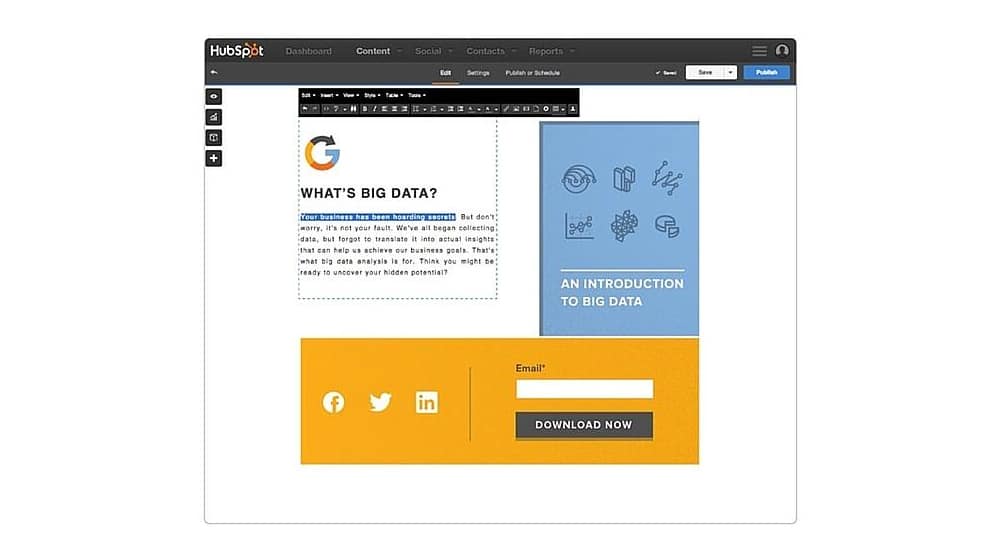
HubSpot has all of this built into the platform. A few features, like the ability to publish to social media, require a subscription to their professional tier, but most of the features listed above are available as part of the base CMS.
HubSpot has a built-in CDN. A content delivery network is crucial for site speed and uptime on the modern internet, to deliver your media to users from a server geographically nearby rather than potentially thousands of miles away. Normally, setting up and configuring a CDN is a tedious and sometimes expensive task, and many sites on other CMS platforms tend to skip it unless it's necessary. HubSpot, meanwhile, has it built in.
HubSpot has their own built-in analytics. You're not stuck with the basic Google analytics – though you can use that as well – and you don't have to get a subscription to another analytics platform. HubSpot is great for a lot of marketing and business tracking, including competitor tracking, contact management, and reporting.
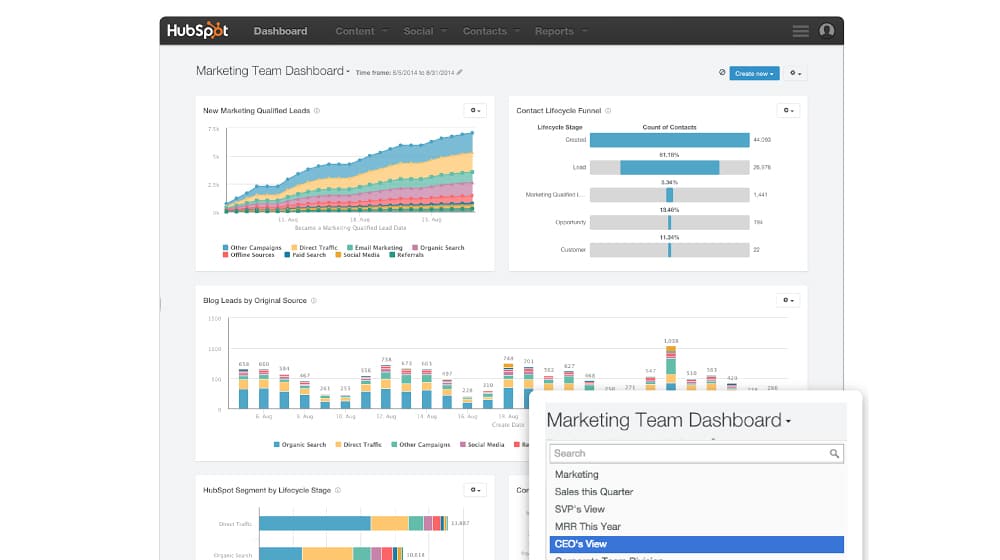
HubSpot has a range of additional expansions. WordPress has them beat in terms of sheer volume, but HubSpot has the advantage of keeping it all in-house. Everything is guaranteed to work together, because it's all developed and maintained by the same people. You can rest assured that you won't have plugin errors, tool incompatibility, or out of date features that become security liabilities.
HubSpot is built for speed. Site speed is a very important modern SEO factor, and HubSpot includes several features aimed at boosting your speed. These include the CDN, automatic image compressions, merged CSS files, page caching, script minification, and more.
HubSpot is secure. While it's impossible to say that anything is 100% secure these days, HubSpot includes several useful security features, including SSL, a built-in firewall, continuous updates, and automated detection of anomalies that indicate a security breach.
If you're convinced, you can request a demo of the HubSpot CMS from this page. If you're convinced and don't want to mess with a demo, you can get started directly from here. I recommend the demo, though, for two reasons. First, it lets you make sure you're actually as into it as you think. Second, the platform costs $300 per month, so if you want to dump it after a few weeks, it's an expensive mistake.
Get to Know the Tools
Once you've set up a fresh HubSpot installation, you should familiarize yourself with the tools available to you.
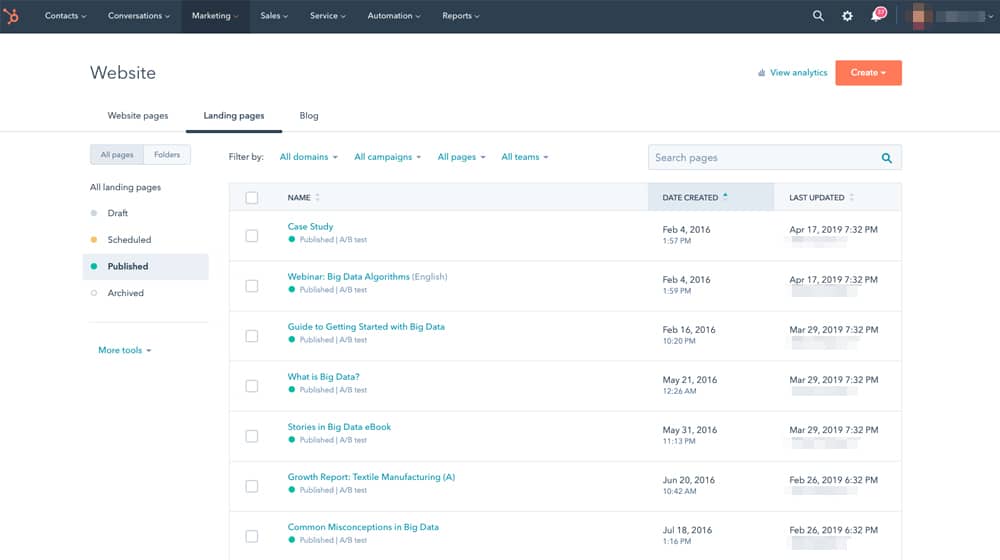
Here's a quick run-down.
- Domain Manager. This tool links your website with a domain name so you can go live.
- File Manager. This is basically a file browser and organizer for your assets, including images, videos, PDFs, and other media that isn't simply just a webpage.
- Design Tools. This is the suite of built-in tools to help you create new pages and templates, as well as edit existing pages and publish new pages.
- Landing and Web Pages. This set of tools helps you create individual pages for either landing pages or standard web pages, and publish them.
- Blog. This is, of course, your basic blog post creator.
- SEO. This tool helps you brainstorm ideas and map out a content strategy centered around topics and clusters of keywords.
- Marketplace. This is a database of modules and templates to expand the functionality of the basic HubSpot CMS. You can think of it like a more moderated and restricted version of the WordPress theme and plugin marketplaces.
There's no limit to the number of pages or templates you can create, so go wild playing with it to familiarize yourself with how the tools work. Getting to know your tools is an important way to build experience with your chosen platform.
In addition to the above tools, there are other tools available as optional extensions, some of which are free and others which require a professional or enterprise-level membership. You can also link up with other HubSpot services, like their Sales or Marketing hubs.
Build Some Pages
When you're designing a website, you need to put together the pages you want to publish. This means everything from your homepage to your About, Contact, Terms, and Privacy Policy pages, to your blog itself. All of these pages are made up of a combination of a template and content. The template is a basic page, defining the purpose of the page and the locations of various types of content. The content, of course, fills out the template.
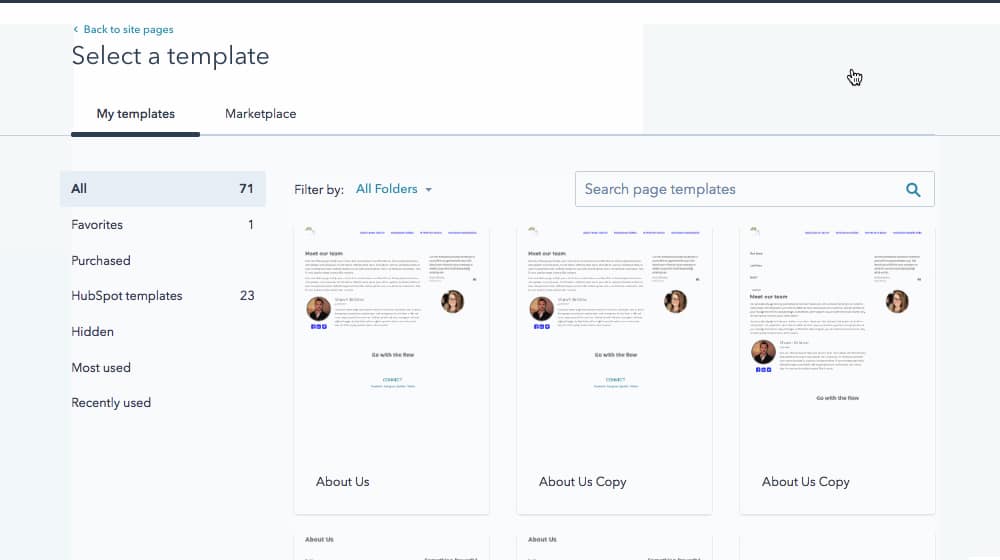
Templates are made up of modules. Individual modules can be things like an image, a form, a call to action, a rich text segment, and so on. This was a lot more innovative and interesting when HubSpot was the only one doing it, but these days you'll be familiar with it if you've spent any time looking at the WordPress Gutenberg block editor. The difference is, with HubSpot, you're putting modules together to create a template. In WordPress, you have a base template that you slot in blocks as your content.
The first thing you want to do is build your global content templates. This means making modules for core elements of your site, like your navigation, and making template pages for core site pages like your homepage, your About page, and your main blog layout.
Don't worry about more marketing-specific pages like individual landing pages. You can make these with marketing-specific tools later, when you need them. For now, focus on the core of your website and your blog.
Develop a Blogging Strategy
The key to running a successful blog is developing a content strategy. You're going to be publishing content on a regular basis, be it once a week, three times a week, daily, or multiple times per day. This constant need for content means you need to have some idea of what you're going to be writing about and publishing. Developing this strategy requires several individual processes.
Define your blog's purpose. Why are you writing your blog? Is it meant to attract users to purchase your products? Is it meant to showcase your own position as a thought leader in your industry? Is it designed to be a hub where you can attract and network with other niche professionals? Is it there to chronicle your life and adventures?
Knowing the purpose of your site helps you aim your content efforts. For example, if you're writing a blog to showcase yourself as a thought leader, you don't want to be writing extremely basic content, you want your content to have depth and innovative ideas in it. Conversely, if you're looking to position your brand as a resource and sell your products, you want your users to know that you know what you're talking about, so in-depth guides – even basic guides – can be very valuable.

Define your audience. Pretty much every blog needs to have a defined audience if it wants to be anything more than a diary out in the open. This typically means defining buyer personas, though you can think of them in another way if you don't want to focus on selling something.
A buyer persona is a sort of generic profile of a person. For example, you might know that your blog sells products often purchased by young mothers, so you define someone who is young, female, a parent, with a certain range of income and education levels, and perhaps some other demographics.
It's common for websites and businesses to have more than one buyer persona, because your audience will be varied and your products will appeal to multiple different groups. Buyer personas allow you to tailor specific marketing efforts to reaching specific segments of your audience. Here's a good guide for developing them.
Develop a keyword list. Web writing no longer relies on having specific keywords included at specific densities in every post, but you do still need to have a great idea of what keywords and what topics you want to cover. This is why HubSpot offers a content development tool to help you create keyword clusters, which can be spun off into a wide variety of different topics.
Keyword research is a deep enough topic that it's worth covering in its own post, so I'm only going to go over the briefest of outlines here.
- Identify user intent. Your users are looking for something online, which can be divided into two categories: informational or actionable. People looking for information can find your blog if you reach them with the right information at the right time. People looking to take action – like make a purchase – can find your site through other means, and your blog can attract them to choose you over a competitor with a worse slate of content.
- Brainstorm a list of topics relevant to anything you can think of. Things your business does, things your users may be interested in, things you can teach; as long as it's relevant to the overall topic, it's worth writing down. For example, as a marketing and blogging business, HubSpot can create topics like "inbound marketing" or "lead generation" or "SEO" as general topics, from which other sub-topics can spin off.
- Spin off your sub-topics. A snowflake method can work well for this if you're a graphically-minded person, otherwise just categories and notes work just as well. For example, you can take SEO and spin it off into technical SEO, SEO copywriting, SEO tools, and so on.
- Make use of keyword research tools to identify keywords for each of your sub-topics, or sub-sub-topics, or however narrow you need to make them to start getting into specific keywords. This allows you to identify topics that have higher search volume to prioritize.
- Identify related topics and search suggestions that can inspire further keyword and content ideas. Make sure to write everything down so it's easier to identify when you've covered a topic before.
Keep in mind that there's generally a "sweet spot" for topics and keywords. If it's too generic and has too high a search volume, competition will be so high you have no real chance of ranking until you're a much larger site. Conversely, if volume is too low or the keyword is too narrow, you might not get enough search traffic for it to be worth the space on the server.
For more details on the keyword research process, check out this post.
Create Great Content
HubSpot's CMS comes with some great built-in SEO tools, so when it comes to creating great content, you primarily need to concern yourself with high quality writing, detailed research, novel ideas, great guides, cited sources, and well-written prose. Easy, right?

Actually writing blog posts based around your choice of topics can be tedious and time-consuming, but it's also quite fulfilling when you write a great piece and see it succeed. Here are a few of my personal tips.
- Do research before you write and see what other content exists for the topic. Look for flaws in that content, areas where it's weak, and out-do it. If it's shallow, do a deep dive. If it's short, write a longer piece. If it's deep but narrow, do a broader view. Put your own unique spin on it.
- Don't be afraid to split a topic into multiple spin-offs as you write. It's easy to leave yourself a hook where you can link to a new post once you publish it later.
- Set a reasonable target length goal – I like around 2,000 words – but don't be afraid to go under or over as necessary to cover the topic in depth. Treat each topic as it deserves.
Also, you can always pay a professional writer to create your content for you. Freelancers can be found anywhere from a content mill like Textbroker to a freelancer hub like Upwork to individual writer websites. Find a freelancer, negotiate terms, and get your content produced while you focus on other marketing efforts.
Promote Yourself
Blogging is no longer something you can just start doing and hope people find you. These days, you absolutely need to promote yourself. Here are some options you can pursue.
- Look for related blogs where you can leave comments with your own expertise. Don't just leave bald links, that's bad form. Instead, just build a reputation for yourself.
- Look for blogs where you can contribute your own content as a guest post.
- Post your content on social media as much as possible. Social media marketing is also worth its own post.
- Add links to your website and blog pretty much anywhere you can, from your author bios on other sites to your email signature to your social profiles to your business cards.
- Look for older content similar to yours that is out of date, and find content that links to it. Ask the people linking to it if they would be willing to change their links to a newer resource, notably your own. You can do the same with links that no longer work, which is called broken link building.
And, of course, don't forget to engage with your audience. Monitor yourself on social media and keep an eye on your blog comments.
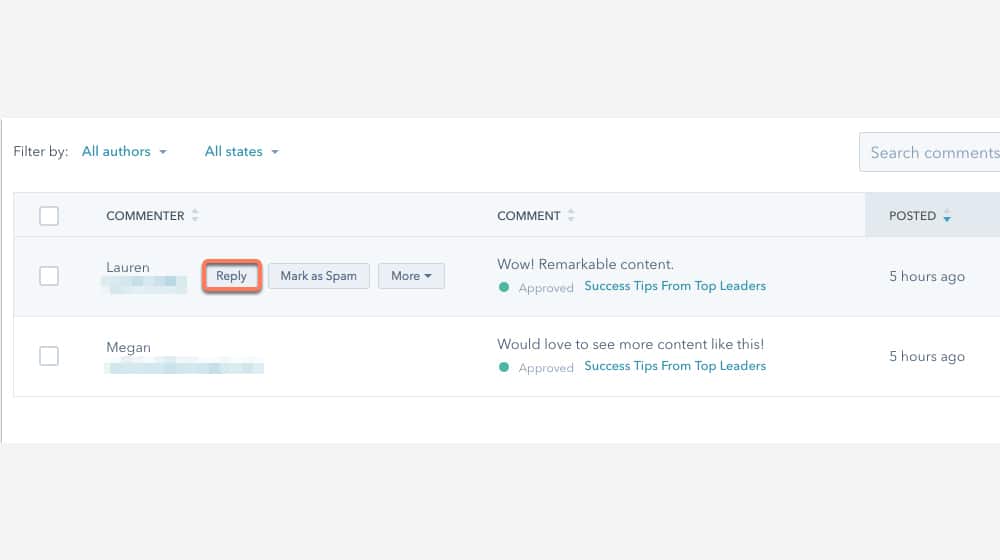
When someone makes a comment or replies to your post, you should reply to them. Try to reply in a way that keeps a conversation going, rather than short, simple answers or basic "thanks!" responses.
Monitor Content Performance
One of the biggest strengths of the HubSpot CMS is their link to their analytics. Combining Google Analytics with the analytics included in HubSpot will give you an extremely detailed picture of how you're performing, from a marketing perspective and from a sales perspective.
The exact data you want to monitor will vary depending on what your goals are. I recommend monitoring traffic numbers, including dividing it up based on source, such as search, direct links, and social media. You should also monitor sales referrals based on your content, and can also monitor indicators like blog comments and social metrics for a more robust idea of performance.
Keep Going
Possibly the most important tip for running and growing a blog, regardless of the CMS you're using, is to keep at it. A blog is not a fire-and-forget apparatus. It's a tool that needs to be used consistently to show improvements. It's much like exercise in that way. Your gains will be slow, especially when you're first starting out, but the longer you keep at it, the better you get. You'll learn what works and what doesn't. You'll learn to engage with your audience. You'll produce better and better content. Eventually, you'll notice your numbers have settled at a higher point than you thought you'd ever reach, and that's when you know…
…your blogging journey has just begun.










November 11, 2019
Thanks for this writeup! One thing I have had a hard time finding is if the Hubspot blog has a feature for related posts, similar to Yet Another Related Posts Plugin for WordPress. Is there anything like that for Hubspot that will show my related posts so users reading my blog posts can see other related blog articles? Thanks in advance
November 11, 2019
Hi Ryan!
There isn't an official plugin or feature for this on HubSpot, although a user on the HubSpot community section showed how you can put together a custom module to pull in posts, either manually or custom. This feature is in beta, but here's the resource if you're interested in reading more: https://community.hubspot.com/t5/CMS-Development/Powerful-Related-Posts-Feature/td-p/186419
You could follow their code example in this link to start pulling in posts and then style it accordingly with CSS (or have a web developer assist).
It seems like custom is the only way to go right now. Related posts are super important though - let me know how it goes and if you end up creating something custom! Good luck.
August 16, 2020
I have been using Hubspot for a long time now. I started off with blogging (it was not easy as I was inexperienced with anything about having my own website) and now I am selling my own merchandise online. Just start with something and you will figure it out eventually.
August 17, 2020
Hi Cheryl! Thanks for your comment. What made you choose HubSpot over WordPress? Happy to hear you're having success with it!
October 31, 2020
Hi Cheryl, do you like Hubspot's blogging platform? I'm thinking of signing up for it but I've read very little about their blog CMS. Ideally I'd like to use WordPress but I want to use Hubspot as my main platform, so I might just settle for Hubspot's blog. Thanks in advance!
December 02, 2020
Exactly what I was looking for. Thank you for taking the time to put this together
December 02, 2020
Thanks John, happy to help!
March 03, 2021
Nice stuff in here James! One thing, if for example I subscribed to this and eventually decide to switch to my own blog, can I still transfer my articles from HubSpot to my own site?
March 04, 2021
Hi Danica!
Assuming you're keeping the same domain, yes, it's possible.
You'd have to carefully download all of your pages, URL structures, and content, and then set them up in a similar fashion with your new CMS.
Then, you'd have to implement redirects from your old URLs to the new ones, assuming the URL structure changed (which it probably did).
It's a lot of work, but it's possible.
I would evaluate why you want to use Hubspot in the first place, especially if you think you want to move to a different CMS in the future.
March 16, 2021
Hey James, is using Hubspot blog free?
March 25, 2021
Hey Brittney! CMS Hub is pretty expensive, more so than the other top 10 content management systems. They have a 14-day free trial if you'd like to try it out, but their "Professional" plan is $3,240/yr at the time of writing, billed annually.
April 12, 2021
Not a Hubspot customer but interesting to see that it has a blog. Do you think it's worth using over WordPress?
April 14, 2021
Hey Scott!
For a blog, it can't compare to WordPress - WordPress is the undisputed king as far as blogging platform goes.
As a whole, HubSpot has great software and their blog platform can still perform admirably.
You just won't have a lot of the benefits that a WordPress blog has, and it may be a little tougher to compete with WordPress sites. They will generally load faster, be better optimized, have a better linking structure, and have other advanced features that are unattainable on a HubSpot blog.
December 23, 2021
Amazing guide you've got here. I was just looking into HubSpot the other day so this is very helpful. I never considered using it before but it seems pretty interesting so far.
December 31, 2021
Thanks Taylor!
A handful of our newest clients are using HubSpot so we've grown a bit more comfortable with it in recent years.
I'm still a WordPress fanboy to my core, but HubSpot isn't all too bad 😉
Happy new year!
January 18, 2022
Nice read! I've always been intrigued about HubSpot's capabilities so this was interesting. I'll still stick with WordPress for now, but this is nice to know.
January 19, 2022
Thanks Rica! Same here 😉